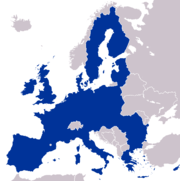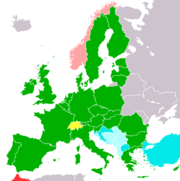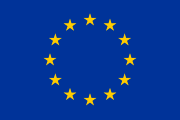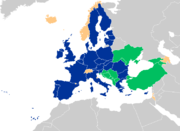List of European Union member states by accession
2007 Schools Wikipedia Selection. Related subjects: European Geography; Recent History
This is a list of European Union member states, their dates of application and accession. It shows the growth of the European Union and its predecessors through enlargement from six members in 1952 to twenty-five in 2004 and twenty-seven members in 2007; as of 2006, at least seven (possibly even more) are expected to join in its future.
The European Union per se was created on 1 November 1993 when the Treaty on European Union came into effect. Twelve of the current 25 member states joined one of the Union's predecessors, either the European Coal and Steel Community (which came into existence on 23 July 1952 and ceased to exist exactly 50 years later), the European Economic Community (which came into existence on 1 January 1958), or the European Community (which came into existence on 1 July 1967 as a merger of ECSC, EEC and the European Atomic Energy Community, and is one of the three pillars of the European Union today).
Candidate countries
In addition to the current twenty-five member states, a number of other European states will join the European Union in the next two decades. Bulgaria and Romania have already finished accession negotiations and will join on 1 January 2007. The ratification process of the Treaty of Accession 2005, which forms the legal framework for the accession of Bulgaria and Romania, was completed on 2006- 11-24 when the German Bundesrat voted in favour.
Croatia, the Republic of Macedonia and Turkey are officially candidate countries; Croatia and Turkey are currently in accession negotiations, while negotiations with the Republic of Macedonia are expected to start in 2007. The remaining states in the Balkans (Albania, Bosnia and Herzegovina, Montenegro and Serbia, including Kosovo under United Nations Security Council Resolution 1244 of 10 June 1999) are officially "potential candidate countries", which means they have a clear perspective for accession over the course of the next decade.
The European Union's Enlargement Commissioner Olli Rehn originally stated that the next enlargement after Bulgaria and Romania would only happen after 2010, due to the European Union's need to sort out its institutional problems first, the European Commission's President José Manuel Durão Barroso later stated that the provisions in the Treaty of Nice were clear enough; while he considered institutional reform necessary, it was not intended to be a stumbling bloc for countries seeking to join the European Union. However, on 25 September 2006 (the day before the accession date of Bulgaria and Romania was officially made public), Barroso stated that a new treaty would be necessary before further enlargement could occur.
|
The official logo of the accession of Croatia to the European Union. |
The official logo of the accession of the Republic of Macedonia to the European Union. |
The official logo of the accession of Turkey to the European Union. |
Countries who failed to join or left
Not all accession attempts have been successful, though, and on one occasion a territory even left the European Union (then European Community).
- While Norway had completed European Community/European Union accession negotiations twice already (with the proposed accession dates having been 1 January 1973 and 1 January 1995, respectively), the accession failed both times when the Norwegians rejected membership in referenda (on 25 September 1972 and 28 November 1994).
- The Danish autonomous territory of Greenland initially joined the European Community together with Denmark, but left on 1 February 1985 after it had acquired home rule and had held a referendum on the issue.
- Morocco applied to join in 1987, but was rejected by the European Council because it was not considered a European country and therefore not eligible to join. (Interestingly, the Copenhagen criteria had not yet been formally agreed upon at that time.)
- Although Switzerland applied to join in 1992, it froze its application after accession to the European Economic Area was rejected in a referendum on 6 December 1992.
Future prospects
- See also: Armenia and the European Union, Cape Verde and the European Union, Georgia and the European Union, Iceland and the European Union, Israel and the European Union, Moldova and the European Union, and Ukraine and the European Union
- This section is incomplete. You can help by adding information about the current situation in the European microstates Monaco and Vatican City, as well as in associated territories (especially Greenland).
It is generally assumed that even with the accession of the states of southeastern Europe, the process of enlargement will not be finished.
- European countries
Armenia, Georgia, Moldova and Ukraine have stated they would like to join the European Union; however, the European Union's response was lukewarm at best. European Union membership is also the subject of political debate in Andorra, Azerbaijan, the Faroe Islands, Iceland, Liechtenstein and San Marino, and the debates in Norway and Switzerland are also still ongoing. While Belarus and Russia are also seen as eligible to join, and while accession to the European Union enjoys public support in Belarus, the lack of democratic structures makes these countries' accession impossible in the short term, especially as the European Union is supporting the Belarussian opposition and civil society in peacefully overthrowing Alexander Lukashenko's regime, which it regards as dictatorial, going so far as to offer concrete benefits for democratic reforms. Furthermore, the European Union is trying to bind Russia more strongly to its own policies and goals through partnership and cooperation agreements.
- Non-European countries
Although the Treaty of Maastricht states that only European countries may apply, a number of countries not generally considered European have also considered membership bids.
The island nation of Cape Verde, part of the island region Macaronesia (which is comprised of Cape Verde, the Portuguese islands of the Azores and Madeira and the Spanish Canary Islands) has stated it wishes to join the European Union. Israel has considered applying for membership; while the European Union and Israel share a common culture, history and society, the ongoing Arab-Israeli and Israeli-Palestinian conflicts and Israel's location in one of the most conflict-ridden regions of the world would be major arguments against its accession. Finally, even Canada's accession has occasionally been proposed, though often rather in a tongue-in-cheek manner; the main arguments used are the very similar cultural standards and viewpoints on matters of international law, especially when juxtaposed with those of the United States. None of the three countries is a member of the Council of Europe, which is a de facto prerequisite for membership under the Copenhagen criteria and the Treaty of Maastricht.
It is generally expected that the states of southeastern Europe will be the next states to join the European Union, and that it will still take some time for Iceland, Norway and Switzerland to join, since public opinion is not yet in favour in those three states. On 19 May 2006, Olli Rehn said that he expected Iceland to join the European Union before Croatia would; he went back on his statement when he stated on 1 December 2006 that Croatia would likely become the European Union's 28th member state.
Listed by accession date
| # | State | Accession | Special territories |
|---|---|---|---|
| 1–6 | 23 July 1952 ( ECSC) 1 January 1958 ( EEC) |
— | |
|
|
|||
| — | |||
| — | |||
| — | |||
| 7–9 | 1 January 1973 ( EC) | ||
| — | |||
|
incl.
excl.
excl. excl. excl. excl. the excl. the |
|||
| 10 | 1 January 1981 (EC) | — | |
| 11–12 | 1 January 1986 (EC) | — | |
| — | |||
| 13–15 | 1 January 1995 | — | |
|
incl.
|
|||
| — | |||
| 16–25 | 1 May 2004 |
excl.
excl. |
|
| — | |||
| — | |||
| — | |||
| — | |||
| — | |||
| — | |||
| — | |||
| — | |||
| — | |||
| 26–27 | 1 January 2007 | — | |
| — | |||
| TBD | in accession negotiations | — | |
| — | |||
| candidate country | — | ||
| potential candidate country | — | ||
| — | |||
| — | |||
| — |
Listed by application date
| # | State | Application | Result/status |
|---|---|---|---|
| — | — | founding members | |
| 1 | 1st: 31 July 1961 2nd: 11 May 1967 |
1st: withdrawn after Charles de Gaulle vetoed the United Kingdom's application 2nd: joined 1 January 1973 |
|
| 2–3 | 1st: 10 August 1961 2nd: 11 May 1967 |
||
| 1st: 10 August 1961 2nd: 10 May 1967 |
1st: vetoed by Charles de Gaulle on 14 January 1963 2nd: joined 1 January 1973 |
||
| 4 | 1st: 30 April 1962 2nd: 21 July 1967 3rd: 25 November 1992 |
1st: withdrawn after Charles de Gaulle vetoed the United Kingdom's application 2nd: withdrawn after a referendum on 25 September 1972 3rd: withdrawn after a referendum on 28 November 1994 |
|
| 5 | 12 June 1975 | joined 1 January 1981 | |
| 6 | 28 March 1977 | joined 1 January 1986 | |
| 7 | 28 July 1977 | ||
| 8 | 14 April 1987 | candidate country, in accession negotiations | |
| 9 | 20 July 1987 | rejected by the European Council (see geographic criteria) | |
| 10 | 17 July 1989 | joined 1 January 1995 | |
| 11–12 | 3 July 1990 | joined 1 May 2004 | |
| 13 | 1 July 1991 | joined 1 January 1995 | |
| 14 | 18 March 1992 | ||
| 15 | 25 May 1992 | frozen after EEA membership was rejected in a referendum on 6 December 1992 | |
| 16 | 31 March 1994 | joined 1 May 2004 | |
| 17 | 5 April 1994 | ||
| 18 | 22 June 1995 | acceding country, to join 1 January 2007 | |
| 19 | 27 June 1995 | joined 1 May 2004 | |
| 20 | 13 October 1995 | ||
| 21 | 24 November 1995 | ||
| 22 | 8 December 1995 | ||
| 23 | 14 December 1995 | acceding country, to join 1 January 2007 | |
| 24 | 17 January 1996 | joined 1 May 2004 | |
| 25 | 10 June 1996 | ||
| 26 | 21 February 2003 | candidate country, in accession negotiations | |
| 27 | 24 March 2004 | candidate country | |
| TBD | not yet | potential candidate country, Stabilisation and Association Agreement (SAA) signed on 12 June 2006; yet to be ratified by Albania, all twenty-five EU member states and the European Parliament (compare this for ratification progress) | |
| potential candidate country, in SAA negotiations since 10 October 2005 (as part of Serbia and Montenegro), mandate for separate negotiations confirmed on 24 July, negotiations restarted on 26 September 2006, negotiations finished 1 December 2006 | |||
| potential candidate country, in SAA negotiations since 10 October 2005 (as Serbia and Montenegro), suspended since 3 May 2006 over non-arrest of Ratko Mladić, mandate for separate negotiations confirmed on 24 July without lifting the suspension | |||
| potential candidate country, in SAA negotiations since 25 October 2005, conclusion only possible after police reforms have been carried out |
Timeline




